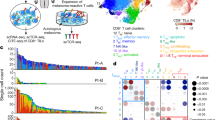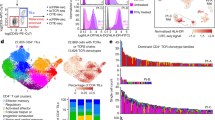Abstract
Previous studies have shown that recognition of melanoma by cytotoxic T lymphocytes may be restricted by HLA-A1, A2 and other HLA antigens. The present study examined the cytotoxic specificity and major histocompatibility complex restriction of cloned cytotoxic T lymphocytes (CTL) isolated from a patient with the HLA phenotype A3,31 who had been immunized with a vaccine prepared from HLA-A1,3 melanoma cells. Cytotoxic assays against HLA-typed allogeneic melanoma cells indicated that cloned CTL from the patient were able to kill allogeneic melanoma cells expressing HLA-A1 but not other HLA-A1-positive cells. Studies on a representative clone indicated that proliferation and cytokine (tumour necrosis factor α) production in response to melanoma cells was also associated with HLA-A1 on melanoma cells. Response to the melanoma cells was associated with interleukin-4 (IL-4) rather than IL-2 production. The antigen recognized in the context of HLA-A1 on allogeneic melanoma cells was detected in cytotoxic assays on cells from 9 of 12 HLA-A1+ melanoma cell lines and did not appear to be the product of the MAGE-1 or-3 genes. These findings suggest that T cells can recognize melanoma antigens in the context of alloantigens and that allogeneic vaccines containing “immunodominant” alloantigens may generate CTL that are ineffective against autologous melanoma. The study does not, however, exclude the possibility that CTL with specificity to the latter may be activated by allogeneic vaccines, and further studies are needed to answer this question.
Similar content being viewed by others
References
Alexander MA, Bennicelli J, and Guerry IV.D. (1989) Defective antigen presentation by human melanoma cell lines cultured from advanced, but not biologically early disease. J Immunol 142: 4070
Anichini A, Fossati G, Parmiani G (1985) Clonal analysis of cytotoxic T-lymphocyte response to autologous human metastatic melanoma. Int J Cancer 35: 683
Apolloni A, Moss D, Stumm R, Burrows S, Suhrbier A, Misko I, Schmidt C, Sculley T (1992) Sequence variation of cytotoxic T cell epitopes in different isolates of Epstein-Bar virus. Eur J Immunol 22: 183
Beverley SM, Enzymatic amplification of RNA by PCR. In: FM Ausubel et al. (eds) Current protocols of molecular biology. (1990) Vol. 2, unit 15,4
Bradstock K, Hewson J, Kerr A, Cabral A, Lee CH, Hughes WG (1983) Expression of terminal deoxynucleotidyl transferase in myeloblasts. Am J Clin Pathol 80: 800
Brocker EB, Zwadlo G, Holzmann B, Macher E, Sorg C (1988) Inflammatory cell infiltrates in human melanoma at different stages of tumor progression. Int J Cancer 41: 562
Carrel S, Tosi R, Gross N, Tanigaki N, Carmagnola AL, Accolla RS (1981) Subsets of human Ia-like molecules defined by monoclonal antibodies. Mol Immunol 18: 403
Chen Q, Hersey P (1992) MHC-restricted responses of CD8+ and CD4+ T-cell clones from regional lymph nodes of melanoma patients. Int J Cancer 51: 218
Crowley NJ, Darrow TL, Quinn-Allen MA, Seigler HF (1991) MHC-restricted recognition of autologous melanoma by tumor specific cytotoxic T cells. Evidence for restriction by a dominant HLA-A allele. J Immunol 146: 1692
Crowley NJ, Slingluff CL, Darrow TL, Siegler HF (1990) Generation of human autologous melanoma-specific cytotoxic T cells using HLA-A2-matched allogeneic melanomas. Cancer Res 50: 492
Darrow TL, Slingluff Jr CL, Seigler HF (1989) The role of HLA class I antigens in recognition of melanoma cells by tumor-specific T lymphocytes. Evidence for shared tumor antigens. J Immunol 142: 3329
Epstein LB, McManus NH, Hebert SJ, Woods-Hellman J, Oliver DG (1981) Microtiter assay for antivirus effectors of human and murine interferon utilizing a vertical light path photometer for quantitation. In: Adams DO, Edelson PJ, Koren HS (eds) Methods for studying mononuclear phagocytes. Academic Press, New York, London p. 619
Espevik T, Nissen-Meyer J (1986) A highly sensitive cell line, WEHI 164 clone 13, for measuring cytotoxic factor/tumor necrosis factor from human monocytes. J Immunol Methods 95: 99
Fossati G, Anichini A, Parmiani G (1987) Melanoma cell lysis by human CTL clones: differential involvement of T3, T8 and HLA antigens. Int J Cancer 39: 689
Fossati G, Anichini A, Squarcina P, Mazzocchi A, Parmiani G (1988) Proliferative and/or cytotoxic activity of lymphocyte clones to autologous human melanoma. Int J Cancer 42: 239
Fossati G, Jaramelli D, Bolsari A, Bogdanovich G, Andreola S, Parmiani G (1984) Primary but not metastatic human melanoma expressing DR antigens stimulate autologous lymphocytes. J Int Cancer 33: 591
Gillis S, Fern MN, Ou W, Smith KA (1978) T-cell growth factor parameters of production and a quantitative microassay for activity. J Immunol 120: 2027
Herin M, Lemoine C, Weynants P, Vessiere F, Van Pel A, Knuth A, Devos R, Boon T (1987) Production of stable cytotoxic T-cell clones directed against autologous human melanoma. Int J Cancer 39:390
Hersey P, Jamal O (1990) Immunological relation between DR antigen expression on melanoma cells and infiltration by CD8+ T cells. Pathology 22: 133
Hersey P, Bolhuis R (1987) Factors influencing the generation of “non specific” MHC unrestricted killer cells and receptors involved in their activity. Immunol Today 8: 233
Hersey P, Edwards A, Coates A, Shaw H, McCarthy WH, Milton GW (1987) Evidence that treatment with vaccinia melanoma cell lysates (VMCL) may improve survival of patients with stage II melanoma. Cancer Immunol Immunother 25: 257
Hersey P, MacDonald M, Schibeci S, Burns C (1986) Clonal analysis of cytotoxic T lymphocytes (CTL) against autologous melanoma: Classification based on phenotype, specificity and inhibition by monoclonal antibodies to T cell structures. Cancer Immunol 22: 15
Hersey P, Murray E, Grace J, McCarthy WH (1985) Current research on immunopathology of melanoma: Analysis of lymphocyte populations in relation to antigen expression and histological features of melanoma. Pathology 17: 385
Hoon DS, Banez M, Okun E, Morton DL, Irie RF (1991) Modulation of human melanoma cells by interleukin-4 and in combination with gamma-interferon or alpha-tumor necrosis factor. Cancer Res 51: 2002
Kawakami Y, Rosenberg SA, Lotze MT (1988) Interleukin 4 promotes the growth of tumor-infiltrating lymphocytes cytotoxic for human autologous melanoma. J Exp Med 168: 2183
Kawakami Y, Zakut R, Topalian SL, Stotter H, Rosenberg SA (1992) Share human melanoma antigens: Recognition by tumorinfiltrating lymphocytes in HLA-A2.1-transfected melanomas. J Immunol 148: 638
Klarnet JP, Kern DE, Dower SK, Matis LA, Cheever MA, Greenberg PD (1989) Helper-independent CD8+ cytotoxic T lymphocytes express IL-1 receptor and require IL-1 for secrete of IL-2. J Immunol 142: 2187
Knuth A, Wolfel T, Klehmann E, Boon T, Meyer Z, Buschenfelde KH (1989) Cytolytic T-cell clones against an autologous human melanoma: Specificity study and definition of three antigens by immunoselection. Proc Natl Acad Sci USA 86: 2804
Mattson DH, Handy DE, Bradley DA, Cologan JE, Cowan EP, Biddson WE (1987) DNA sequences of the genes the encode CTL-defined HLA-A2 variants M7 and DK1. Immunogenetics 26: 190
Mizuochi T, Hugin AW, Morse III HC, Singer A, Buller RML (1989) Role of lymphokine-secreting CD8+ T cells in cytotoxic T lymphocyte response against vaccinia virus. J Immunol 142: 270
Mosmann T (1983) Rapid colorimetric assay for cellular growth and survival: Application to proliferation and cytotoxicity assays. J Immunol Methods 65: 55
Mukherji B, Guha A, Chakraborty NG, Sivanandhan M, Nashed AL, Sporn JR, Ergin MT (1989) Clonal analysis of cytotoxic and regulatory T-cell responses against human melanoma. J Exp Med 169: 1961
Muul LM, Spiess PJ, Director EP, Rosenberg SA (1987) Identification of specific cytolytic immune responses against autologous tumor in humans bearing malignant melanoma. J Immunol 138: 989
Pandolfi F, Boyle LA, Trentin L, Kurnick JT, Isselbacher KJ, Gattoni-Celli S (1991) Expression of HLA-A2 antigen in human melanoma cell lines and its role in T-cell recognition. Cancer Res 51: 3164
Reinherz E, Schlossman S (1982) Human T-lymphocyte differentiation. Immunol Today 3: 239
Salgame P, Abrams JS, Clayberger C, Goldstein H, Convit J, Modlin RL, Bloom BR (1991) Differing lymphokine profiles of functional subsets of human CD4 and CD8 T cell clones. Science 254: 279
Salmeron MA, Seki H, Platsoucas C, Itoh K (1990) T cell clones in human metastatic melanoma possessing both cytotoxic and interleukin-2 production in response to autologous tumor cells. J Cell Biochem 14B, 92 (Abs.)
Schibeci S, Hersey P, Cheresh D (1989) Potentiation of interleukin-2 production and its binding by monoclonal antibodies to the gangliosides GD3 and GD2. Cancer Immunol Immunother 29: 109
Traversari C, Van der Bruggen P, Luescher LF, Lurquin C, Chomez P, Van Pel A, De Plaen E, Amar-Costesec A, Boon T (1992) A nonapeptide encoded by human gene MAGE-1 is recognized on HLA-A1 by CTL directed against tumor antigen MZ2-E. J Exp Med 176, 1453
Van der Bruggen P, Traversari C, Chomez P, Lurquin C, De Plaen E, Van den Eynde B, Knuth A, Boon T (1991) A gene encoding an antigen recognized by cytolytic T lymphocytes on a human melanoma. Science 254: 1643
Vartdal F, Gaudenack G, Funderud S, Bratlie A, Lea T, Ugelstad J, Thorsby E (1986) HLA class I and II typing using cells positively selected from blood by immunomagnetic isolation—a fast and reliable technique. Tissue Antigens 28: 301
Widmer M, Bach F (1981) Antigen driven helper cell-independent cloned cytolytic T lymphocytes. Nature 294: 750
Wolfel T, Klehmann E, Muller C, Meyer Zum Buschenfelde K-H, Knuth A (1989) Lysis of human melanoma cells by autologous cytotoxic T cell clones. Identification of human histocompatibility leukocyte antigen A2 as a restriction element for three different antigens. J Exp Med 170: 797
Yamada T, Holmes EC, Golub SH (1990) Differential regulation by interleukin 4 and interferon-gamma of an autologous melanoma-specific cytotoxic T cell clone and tumorinfiltrating lymphocytes from which it was established. Cancer Commun 2: 113
Author information
Authors and Affiliations
Rights and permissions
About this article
Cite this article
Chen, Q., Smith, M., Nguyen, T. et al. T cell recognition of melanoma antigens in association with HLA-A1 on allogeneic melanoma cells. Cancer Immunol Immunother 38, 385–393 (1994). https://doi.org/10.1007/BF01517208
Received:
Accepted:
Issue Date:
DOI: https://doi.org/10.1007/BF01517208




